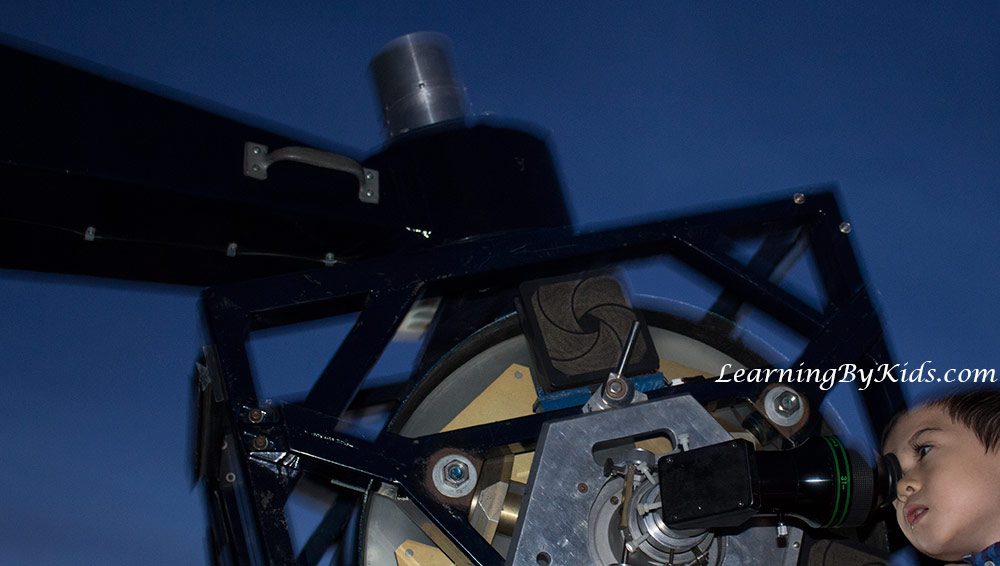We love stargazing. There’s something about the twinkling stars, wandering planets, celestial visitors (like comets), dusty nebulae, and whirling galaxies that always fascinates. Naturally, the night sky with its many wonders has steered us toward a growing love for astronomy. Astronomy is the science of the stars, planets, and other outer space objects that comprise the universe.
We decided to attend our first star party. A star party has nothing to do with celebrities at all. Rather, a star party is a gathering of astronomers, both amateur and seasoned, who all participate in observing the sky and in discussing astronomy. The star party took place at the Tierra del Sol Dark-sky Observing Site. We got a chance to view the heavens through the 22-inch LippRitchey-Chretien reflecting telescope.
We then visited the Palomar Observatory, which is both owned and managed by the California Institute of Technology (more commonly known as Caltech). The Palomar Observatory is open daily, except for December 24th and 25th (Christmas Eve and Christmas Day). It can also close if weather conditions make travel difficult. The observatory, after all, sits at the very top of the mountain; therefore, the road leading to and from the Palomar Observatory winds, curves, even turns considerably (beware of daredevil motorists and motorcyclists that frequent the route). It is best to call the Palomar Observatory‘s public information line to keep updated about the observatory’s day-to-day operational status or unexpected closure. Also, there are no gas stations at all on Mount Palomar, so be advised to check your fuel gauge before you make the drive.
The Palomar Observatory is famous for its large 200-inch telescope. It was named after solar astronomer George Ellery Hale. George Ellery Hale built his first telescope at the age of 14 years old. Three years later he went on to attend college at the Massachusetts Institute of Technology (MIT). At MIT, George invented the spectrohelioscope — a special telescope to study the sun. He also had a history with the Harvard College Observatory. Besides the Palomar Observatory, George Ellery Hale likewise founded the Yerkes Observatory (located in Wisconsin but operated by the University of Chicago), the Mount Wilson Observatory (in Los Angeles), as well as the Hale Solar Observatory (in Pasadena, California).
The Hale Telescope at the Palomar Observatory has no lenses, just a primary mirror with a diameter of 200 inches. The mirror is curved and weighs 14.5 tons (the telescope itself, meanwhile, weighs 530 tons). The telescope works because its primary mirror collects light from the universe and focuses it. A scientific instrument or a camera can be placed at that primary focus’ area. Or, a secondary mirror can reflect the light onto a different path for either additional mirrors or further scientific instruments. There are also adaptive optics systems that help correct any distortions from the Earth’s atmosphere; hence, the image delivered is clear.
Construction of the Palomar Observatory‘s Hale Telescope was a long process. Preparations were first made in 1935. The dome was constructed from 1936 until 1939. The telescope’s structure also took three years to build, from 1936 to 1939. But the mirror was another story. The mirror was first cast in December 1934. Then in March 1936 it took 16 days for the mirror to travel from New York (where it was made) to Pasadena where it had to be ground to its appropriate shape. The mirror originally weighed 20 tons and then was ground down to 14.5 tons. World War II delayed work on the mirror. The mirror at last arrived at the Palomar Observatory grounds in November 1947. Many tests had to be performed on the mirror. Numerous polishings and adjustments had to be made to it. Even though the telescope was christened in June 1948, it was not yet complete. The Hale Telescope’s first “official” photos took place in January 1949 (thanks to Edwin Hubble no less). By November 1949 the Hale Telescope was ready for full-scale operations.
The Palomar Observatory‘s dome measures 135 feet tall, with a diameter of 137 feet. Interestingly enough, these dimensions parallel those of the Pantheon in Rome. The dome also has two shutters that total a weight of 125 tons. The shutters open at night. And, the dome can rotate.
The Palomar Observatory has a mini gift shop. In addition to souvenirs, you can also purchase tickets at the mini gift shop for the guided tour of the observatory.
Thanks to both the Tierra del Sol Dark-sky Observing Site and the Palomar Observatory, we’ve learned about a variety of astronomical telescopes. And, they’ve continued to ignite our curiosity about the elegance of the cosmos.









